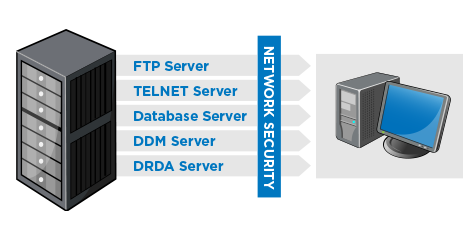Network Access to IBM i Servers
The figure below shows how Network Security acts as your software firewall between networked clients and your IBM i servers. Network Security eliminates the problems you would see in the previous scenario:

Network Access controlled by Powertech Network Security
- Network Security provides a secured audit and reporting capability so you can easily see who is doing what. It also provides real-time alerts when a user tries to circumvent the access rules you've specified.
- Network Security allows you to configure network access rules to control who can do what. For example, using Network Security you can enforce network rules that say "Bob is allowed to download the payroll file, but cannot upload the file, or modify it in any way."
Network Security integrates with the IBM i network server programs at the exit point level. When you activate Network Security, several exit point programs are installed in the IBM i registration facility. You can view the names of these exit-point programs using the IBM i WRKREGINF (Work with Registration Information) command.
The Powertech Network Security exit point programs are called when someone makes a network request to the associated server. For example, when a user requests an FTP logon, the IBM i FTP server passes control to the Network Security exit point program to allow Network Security to validate the request. Network Security may tell the FTP server to accept or reject the FTP logon request, or to perform some other action, such as sending an alert message that an intruder has tried to penetrate the system.
For a complete overview of the IBM i servers and their functions, see Appendix B: Servers and Functions. You'll find useful information to help you define your Network Security access rules.
 Previous
Previous 